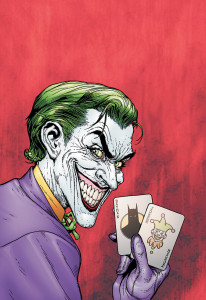There are actually a few other version of The Man who Laughs including one from 1921 and 1971 but the 1928 is the most well know, the 1966 is the most infamous and the 2012 is the most recent, so that covers the major base.
Before I end The Man who Laughs I just wanted to discuss its impact on popular culture.
Have you ever heard of the Joker? The Joker’s look is based on Conrad Viedt’s make-up from the 1928 movie. In fact a one-shot Batman comic from 2005 is called “The Man Who Laughs. ”
but there are some more (got these off of Wiki and there is more)
-In H.G. Wells’ The Island of Doctor Moreau (1896), Moreau refers to L’Homme qui Rit when explaining the nature of his experiments to the protagonist.
-A short story by the name of “The Laughing Man” (first published in 1949) is featured in J. D. Salinger’s Nine Stories (1953). The story appears to be influenced by The Man Who Laughs, featuring an individual facially disfigured in his childhood by criminals who have kidnapped him.
-The novelist and essayist Ayn Rand adapted Hugo’s term “comprachicos” for her own purposes in a noted essay, published in The Objectivist in 1970.
-In James Ellroy’s book The Black Dahlia (1987), the mutilation murder of Elizabeth Short is partially inspired by a painting of Gwynplaine.
-In the 2003 “Wild Cards” episode of the Justice League animated series, The Joker infiltrated a TV station by using the alias “Gwynplaine Entertainment”.
-Laughing Man, a character in Japanese anime TV series Ghost in the Shell: Stand Alone Complex (2002–2003) and inspired by J. D. Salinger’s short story “The Laughing Man”.
-In the 2010 Rob Zombie album, Hellbilly Deluxe 2, the last song is titled “The Man Who Laughs” and is based on the story of the same name.
Well I do think the characters could have been richer or just more interesting it does that Gwynplaine’s look does inspire people, albeit more villainous than the character or what Hugo was going with the character’s laughing face as mirror to an elitist society but whatever.
Moving on, the next book is about a deformed French guy who lives in a Paris Landmark and the story has been made into a famous musical and lot movies. Yeah, it’s Phantom of the Opera. (though there will be a hiatus till then )
Follow thehunchblog



